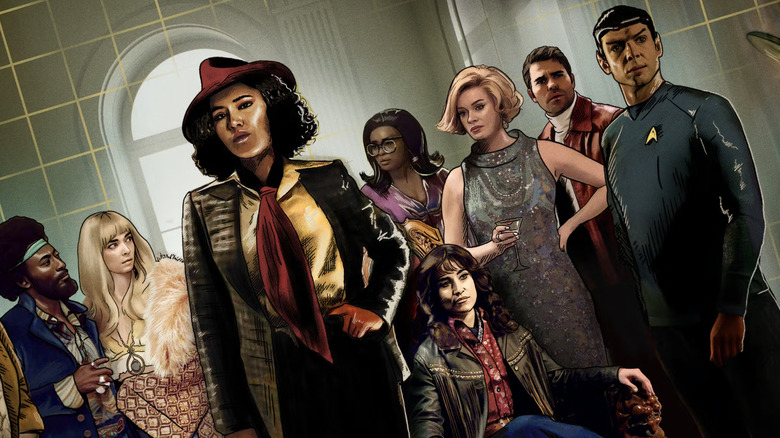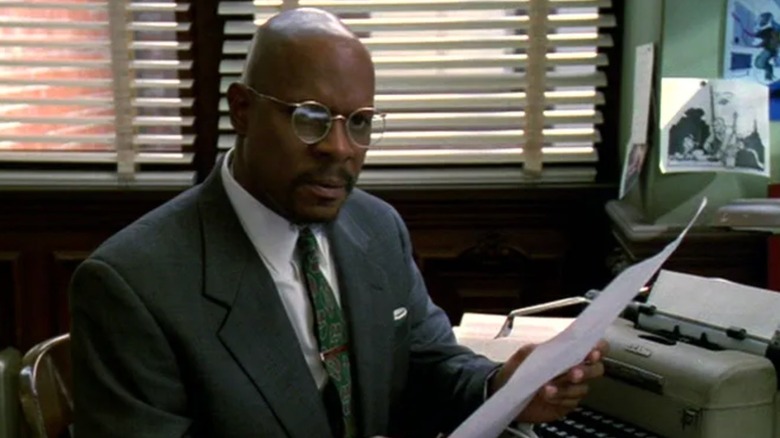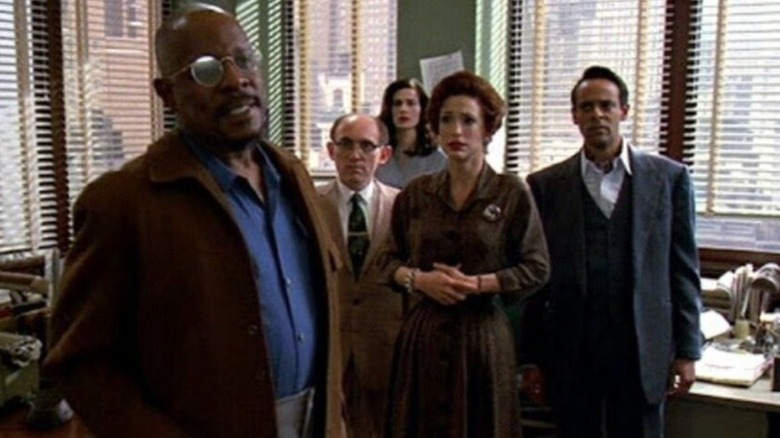Star Trek: Strange New Worlds' Holodeck Episode Began As A Tribute To A DS9 Masterpiece [Exclusive]
Spoilers for episode 4 of "Star Trek: Strange New Worlds" season 4, titled "A Space Adventure Hour," episode follow.
The newest episode of "Star Trek: Strange New Worlds" — "A Space Adventure Hour," written by Dana Horgan & Kathryn Lyn — features the show going back to the past. Except, it's not a time travel episode. To test a prototype holodeck, La'an (Christina Chong) crafts a murder mystery story set in mid-20th century Hollywood where she's the detective, Amelia Moon. And the suspects are the cast and crew of a space adventure series, "The Last Frontier," that's about to be canceled.
The episode has enough metatext to fill the whole Enterprise, because "The Last Frontier" is a clear stand-in for "Star Trek: The Original Series." However, the writers weren't just thinking about "TOS" when it came to "A Space Adventure Hour."
/Film's Jacob Hall recently spoke with "Strange New Worlds" co-showrunners Akiva Goldsman and Henry Alonso Myers and got the scoop. Apparently, "A Space Adventure Hour" went through a fair bit of development to reach its current form. The kernel of the idea, though, came from the "Star Trek: Deep Space Nine" episode "Far Beyond the Stars," where Captain Ben Sisko (Avery Brooks) imagines he is Benny Russell, a science-fiction writer living in 1950s New York City. Or, perhaps, Russell is dreaming of being Sisko.
Goldsman and Myers acknowledged the holodeck premise of "A Space Adventure Hour" might seem like cheating, since the concept of this technology was only introduced in "Star Trek: The Next Generation," which takes place nearly 100 years after "Strange New Worlds." But Goldsman (who has said canon can be loose) countered that "Star Trek: The Animated Series" depicted a similar device when Kirk was captain of the Enterprise. (The "Rec Room" in the episode "The Practical Joker," specifically.)
"So we were like, 'Okay. Well, if they have it one year beyond Kirk's live-action Enterprise, then they must have beta tested it somewhere along the way. Why not beta test it in the flagship?'" explained Goldsman. Bringing in a holodeck beta test was the fine-tuning another episode premise needed.
A Space Adventure Hour looks Far Beyond The Stars
According to Goldsman, the "Strange New Worlds" writers were working on "a standalone story about a science-fiction show at Paramount that was much more literal," the way that "Far Beyond the Stars" set itself in the office of a 20th century science-fiction magazine. The episode would presumably still parallel real "Star Trek" history (and recast the regular actors in new roles), but wouldn't have the holodeck framing device to ground the story in the literal reality of the show. Goldsman, though, said the idea starting getting away from them when they approached it as a standalone episode:
"The more we dug into it, the more complicated it got because in fact, the show that we were talking about that had a lot of characters in it that aren't yet in the show, the original series had, there's no Pike, so it stopped being literal and as we delved further and further into it. It started to get a little bit more hyperbolic and extreme and so then we moved it around and it found its way to the holodeck episode."
Myers also compared "A Space Adventure Hour" to an episode from their first season, "The Elysian Kingdom." In that one, the Enterprise crew become convinced they're characters in a fantasy story book. The setting is very different from "Far Beyond The Stars" and now "A Space Adventure Hour," but it has the same gimmick of placing the regular cast in different roles. Myers explained:
"We were essentially doing a style of episode that was very much like a holodeck where our characters got to become other characters, and we found a way to do that because that's like a gift to your actors and it lets them play and have fun, and it makes the episode bigger and better in many ways."
"The Elysian Kingdom" itself nods to "Far Beyond The Stars" with an Easter Egg — the story book was written by Benny Russell. It makes sense that Benny Russell is on the minds of the "Strange New Worlds" team, because the episode is one of the most beloved in all of "DS9" and "Star Trek" itself. Does "A Space Adventure Hour" come close to its primary influence?
Deep Space Nine went were other Star Trek shows wouldn't
"Star Trek" is about a utopian future where humanity has finally overcome its historical ills; greed, prejudice towards different groups of each other, etc. "Deep Space Nine" is the "Trek" that most remembers what humanity is like now and dares to explore how even paradise isn't perfect.
In the two part episode "Past Tense," the main characters go back to Earth in 2024, where homelessness has become an epidemic. The show's grim prediction turned out to be spot on. In the "present day" of the 24th century there's the alien race known as the Ferengi, and one Ferengi we get to know well is Quark (Armin Shimerman). The Ferengi are rapacious capitalists in a culture where profit comes before everything. They're more like modern humans than the actual humans in "Star Trek" are. As Quark says to Sisko in season 2 finale "The Jem'Hadar," "We're a constant reminder of a part of [humanity's] past you'd like to forget."
Not coincidentally, "DS9" was the first "Star Trek" to have a Black man as its lead. Even if Sisko himself never faced racism for his heritage, the show wasn't a color blind fantasy that pretended that racism never existed. In "Far Beyond the Stars," there's no nostalgia, and the episode confronts us with the fact that a mere 40 years before "DS9" aired, a man like Sisko would never be starring in a TV series. Benny writes a story about a space station commanded by a Black man and his editor Douglas Pabst (René Auberjonois) kills the story before it can be published.
"A Space Adventure Hour" plays it safer than "Far Beyond The Stars." The heart of the episode, per Myers, is when Hollywood power agent Joanie Gloss (Celia Rose Gooding, who plays Uhura) explains that canceling "The Last Frontier" is a terrible idea because the show addresses social ills and can help people dream of a better world. But there's no sign of those ills in the holodeck-generated 1960s.
As meaningful as it is to have Uhura's actor sum up the importance of "Star Trek," a Black woman having power in 1960s Hollywood is the sort of historical incongruity that never happens in "Far Beyond the Stars." "Star Trek" invites us to dream of a better future, but whitewashing the past makes it hard to get there.
"Star Trek: Strange New Worlds" is streaming on Paramount+, with new episodes premiering on Thursdays.


